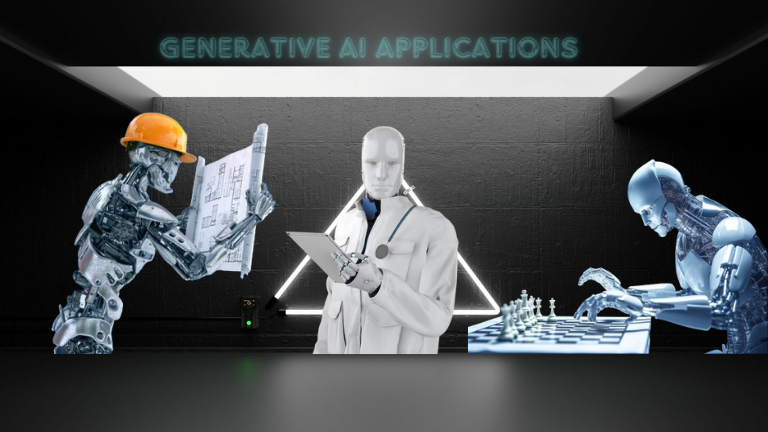A subfield of artificial intelligence known as “generative AI”. It uses data or human input to produce original and lifelike outputs, including text, graphics, audio, and video. The industries, healthcare, education, and entertainment, stand to gain significantly from its potential transformation. some of the most noteworthy and inventive generative AI applications by industry and discuss how they could increase creativity, productivity, and innovation.

Healthcare
Ingenious applications of generative AI, including producing accurate medical images for diagnostics, are transforming the healthcare sector. Imaging diagnostic accuracy is increased when artificial intelligence (AI) is used to produce high-quality synthetic images from MRI and CT scans. AI also expedites the creation of new medications by forecasting drug interactions and enhancing chemical structures. Thanks to generative artificial intelligence (AI), which evaluates genetic data, forecasts treatment outcomes, and recommends patient-specific drug compositions, personalized medicine is poised to usher in a new age. AI also enhances customized therapy, diagnostics, and drug development.
Real Estate
In addition to helping with individualized property searches based on buyer interests, generative AI quickly estimates the worth of real estate, optimizes rental pricing taking market dynamics into account, and more. By giving information for preventive maintenance, it reduces costs and raises the standard of the property. It speedily visualizes properties and evaluates customizations by automating the creation of floor plans, virtual staging, and remodeling simulations. It is transforming parts of real estate appraisal, search, and presentation even as its full potential is still being realized.
Cybersecurity
Enhancing threat detection and prevention with AI is crucial for bolstering cybersecurity defences. It provides real-time notifications for preemptive reactions to network anomalies as part of its function in intrusion detection systems (IDS). Artificial intelligence (AI) uses behavioural analysis as a technique to spot abnormalities that may indicate risky behaviour. One of the most important steps in recognizing Advanced Persistent assaults (APTs) is to search through past data for slow-moving, subtle cyber strikes. Cybersecurity professionals are utilizing generative AI to detect irregularities in network security, carry out behaviour-based analysis, and develop new encryption methods. When these efforts are combined, strong cybersecurity defences are produced.
Robotics
Robotic automation uses artificial intelligence (AI) algorithms to analyze sensor data, allowing for human-machine collaboration and environment adaptation. Learning-based models help robots become more adaptive so they can deal with unexpected situations and get better over time. Effective communication between humans and robots is made possible by sophisticated models of human-robot interaction that can identify movements and facial expressions. Robots’ capacity to make deft decisions in real time is improved by AI-driven decision-making, which is important in situations when accuracy is required. Artificial Intelligence (AI) optimizes task allocation and coordination in collaborative production processes, paving the way for flexible and adaptable robotics in the future.
Customer Service
Gen AI improves customer service by providing instantaneous answers to questions via email, phone, and live chat. In addition to automation, it supports human experts in jobs like call analysis and information search. Users can ask for travel guidance and obtain tailored recommendations thanks to hyper-personalization. Trained on a wide range of factors, the AI-powered assistant uses past data to evaluate flight costs, helping travellers make the best booking choices and improving the overall customer experience with knowledgeable, tailored support.
Gaming
Artificial Intelligence is changing realistic experiences and content development in the gaming industry. AI uses past data and user behaviour analysis to provide personalized content in-game that increases player engagement. While procedural world generation ensures varied and surprising game landscapes, it additionally reduces the workload for developers. Realistic behaviour is displayed by AI-driven non-player characters, which enhances storytelling. Deep involvement is promoted via dynamic story evolution, which modifies narratives in response to player choices. Artificial Intelligence (AI) generates realistic virtual worlds and modifies them instantly to provide dynamic and responsive experiences. The impact of generative AI may be seen in VR game content, as it creates immersive and visually appealing virtual environments.
Education
When education and artificial intelligence come together, the result is content that is customized for each student depending on their performance and preferences. Adaptive learning routes are designed to dynamically modify the complexity of lessons in order to maintain student engagement and avoid dissatisfaction. AI-driven tests surpass conventional techniques by offering thorough insights into student performance. Educator activities are streamlined by automated grading and fast feedback methods, which create a responsive learning environment. Personalized supervision is provided by virtual tutors and AI-powered tutoring systems, while generative AI supports collaborative online learning, individualized study programs, and virtual classroom support.